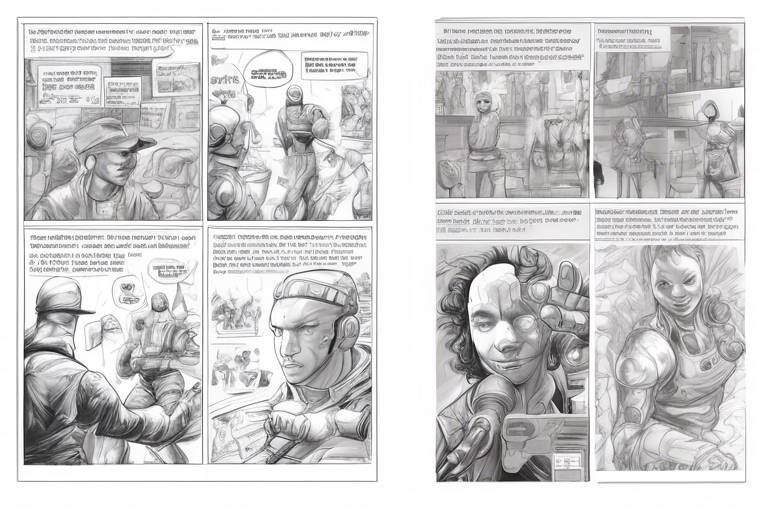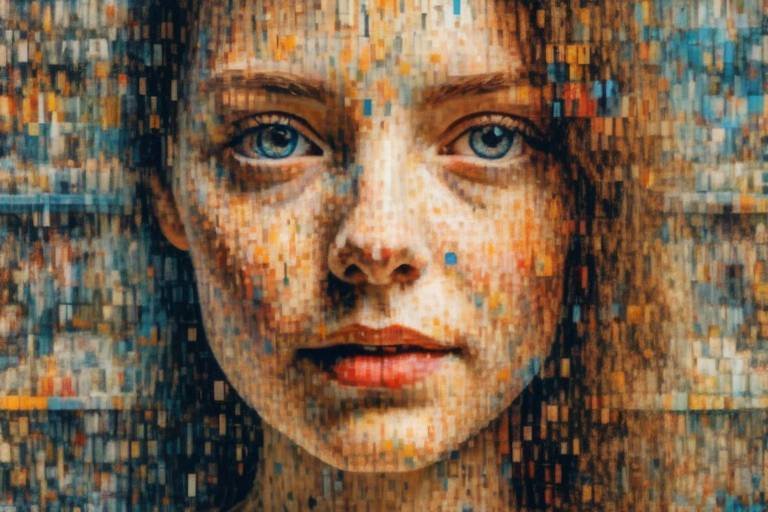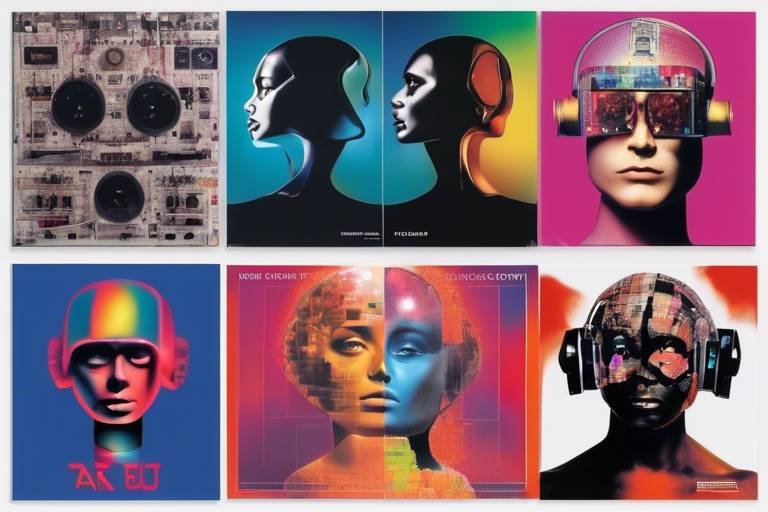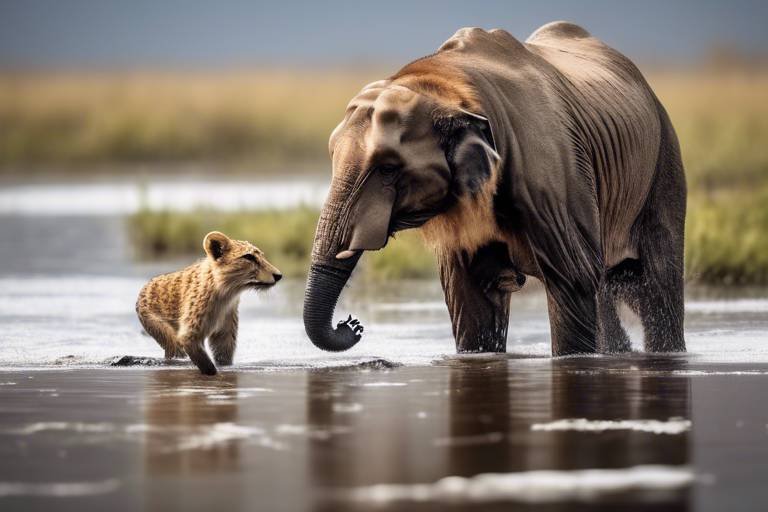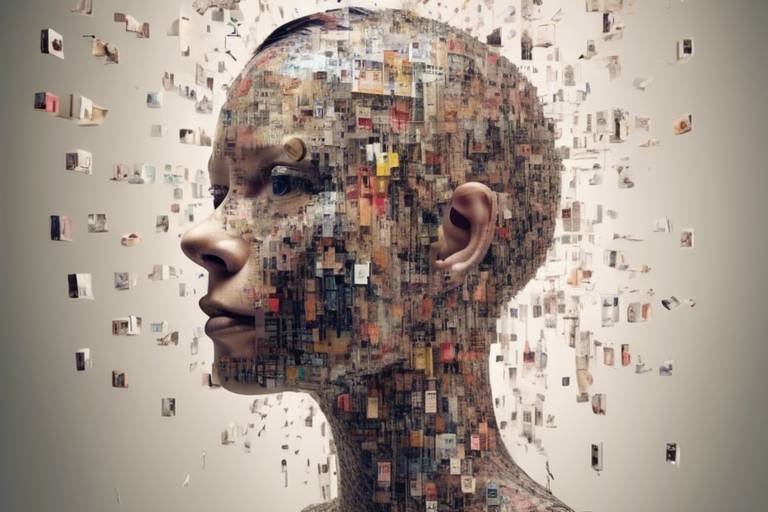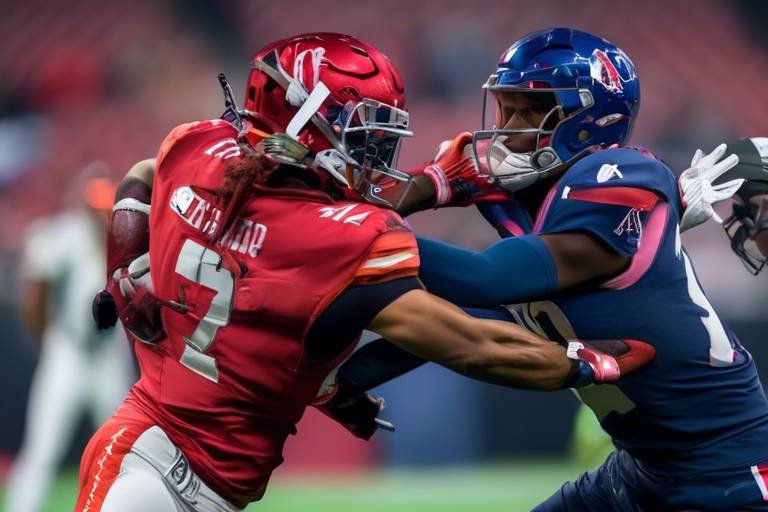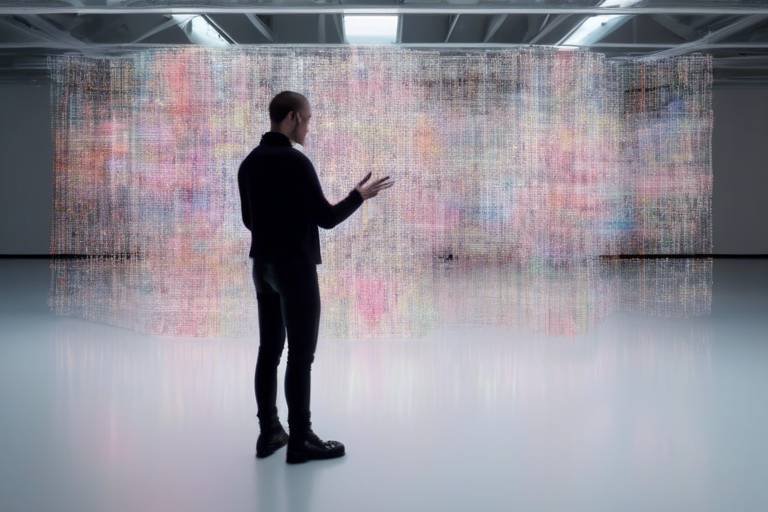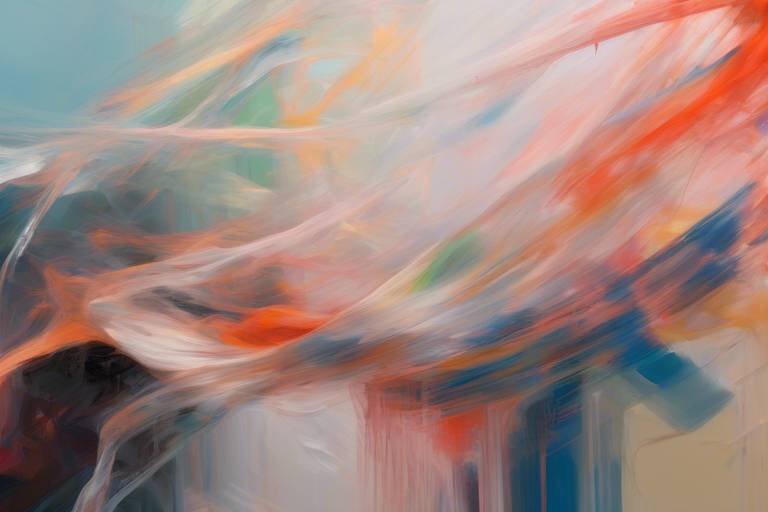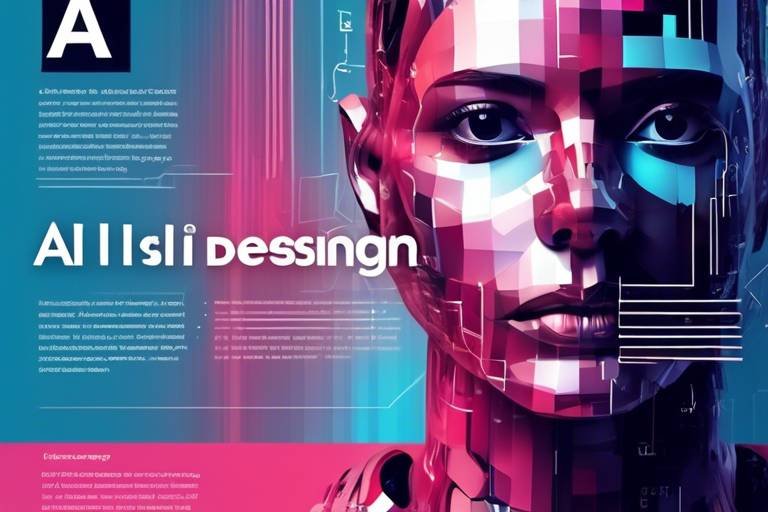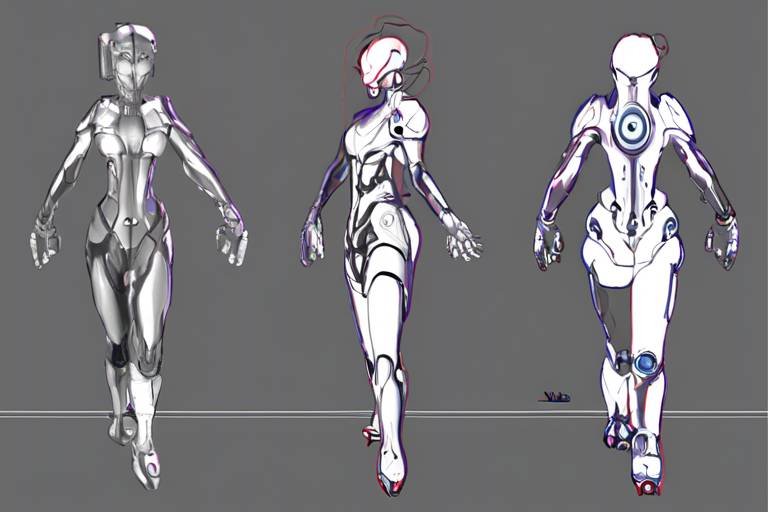The Impact of AI in Sketching Comics
In recent years, the comic industry has witnessed a remarkable transformation, largely driven by the advent of artificial intelligence. This innovative technology is not just a buzzword; it’s a game-changer that is reshaping how comics are created, consumed, and appreciated. Imagine a world where artists can spend less time on repetitive tasks and more time weaving intricate stories that captivate audiences. Sounds exciting, right? Well, that’s exactly what AI is bringing to the table!
AI is enhancing creativity and efficiency in comic creation, allowing artists to explore new avenues of expression. By leveraging sophisticated algorithms and tools, comic creators can generate ideas, design characters, and even develop plots that resonate with readers. This fusion of technology and artistry is paving the way for a future where storytelling is not just a linear journey but an interactive experience that engages audiences on multiple levels.
But how is this possible? Let’s delve deeper into the various ways AI is influencing the comic industry. From AI-powered tools that assist in the creative process to data-driven insights that shape narrative development, the impact of AI is profound. It’s like having a creative partner who never runs out of ideas and can help you push the boundaries of your imagination.
As we explore the intersection of AI and comics, we’ll uncover how this technology is not only enhancing artistic capabilities but also revolutionizing storytelling. Are you ready to discover the future of comics? Buckle up, because the journey is just beginning!
Discover the various AI-powered tools available to comic artists today, enabling them to streamline their creative processes, generate ideas, and enhance their artwork with advanced technology. These tools range from character design generators to coloring assistants that can save hours of work. Imagine an artist being able to input a few parameters and having a unique character design generated in seconds!
Here’s a quick overview of some popular AI tools:
| Tool Name | Functionality |
|---|---|
| Artbreeder | Generates unique character designs based on user inputs. |
| DeepArt | Applies artistic styles to images using neural networks. |
| Runway ML | Offers tools for video editing and image generation. |
These tools are revolutionizing the way artists approach their work, allowing them to focus on what truly matters: storytelling.
Explore how AI can inspire comic creators by providing unique ideas, styles, and perspectives, ultimately enhancing their creative output and pushing the boundaries of traditional storytelling. With the help of AI, artists can experiment with different styles and techniques, leading to a richer visual narrative.
One of the most exciting aspects of AI in comics is its ability to generate unique character designs. Artists can input specific traits or aesthetics, and the AI can produce a variety of options that they might not have considered. This not only saves time but also opens up a world of possibilities for character development.
Moreover, AI can assist artists in customizing character traits and backstories. By analyzing popular themes and reader preferences, AI can suggest traits that resonate with audiences, providing depth and relatability to creations. It’s like having a brainstorming buddy who knows exactly what readers are looking for!
Another fascinating application is the use of style transfer algorithms. These algorithms enable artists to apply various artistic styles to their characters, resulting in visually striking and diverse comic illustrations. Imagine a superhero drawn in the style of a classic painter or a whimsical creature illustrated with a modern twist!
AI can also assist in automating repetitive tasks, such as inking and coloring. This allows artists to focus more on storytelling and less on technical execution. Picture this: instead of spending hours perfecting the ink lines, an artist can let the AI handle that while they dive deep into crafting engaging dialogue and plot twists.
Delve into how AI contributes to narrative development in comics, helping writers create engaging plots and character arcs through data-driven insights and analysis. By analyzing reader preferences and trends, AI can inform plot development, ensuring comics resonate with audiences and maintain their interest.
Discover how AI can analyze reader preferences and trends to inform plot development, ensuring comics resonate with audiences and maintain their interest. This data-driven approach allows writers to craft stories that are not only compelling but also aligned with what readers want.
Explore the concept of interactive comics where AI enables readers to influence story outcomes, creating a dynamic and immersive experience that redefines traditional comic formats. Imagine a comic where your choices dictate the direction of the story—how cool is that?
Address the challenges and ethical dilemmas that arise from using AI in comic creation, including issues of authorship, originality, and the impact on traditional artists in the industry. As we embrace this technology, it’s crucial to consider its implications and ensure that it complements rather than replaces the unique human touch that defines art.
- How does AI create character designs? AI uses algorithms to analyze existing designs and generate new ones based on user inputs.
- Can AI write comic scripts? While AI can assist in generating ideas and analyzing trends, the creative storytelling aspect still relies on human writers.
- Is AI a threat to traditional comic artists? AI is a tool that can enhance creativity, but it should be viewed as a complement rather than a replacement for traditional artistry.

AI Tools for Comic Artists
In the vibrant world of comic creation, artificial intelligence (AI) is emerging as a powerful ally for artists. Gone are the days when artists had to rely solely on traditional techniques and their own imagination. Today, a plethora of AI-powered tools are available, each designed to enhance the creative process and streamline workflows. Whether you're a seasoned comic artist or a budding creator, these tools can transform the way you approach your craft.
One of the most exciting aspects of AI tools is their ability to generate ideas. Imagine having a brainstorming partner that never runs out of inspiration! Tools like Artbreeder allow artists to combine and modify images to create unique character designs and settings. This not only saves time but also opens up a world of possibilities. Artists can experiment with different styles and concepts without the pressure of starting from scratch.
Moreover, AI can assist in the actual creation of artwork. Tools such as Clip Studio Paint and Adobe Fresco integrate AI features that help with inking and coloring. These programs can automatically detect line art and apply color palettes based on the artist's preferences. This means artists can focus on storytelling rather than getting bogged down by tedious tasks. For instance, if an artist struggles with coloring backgrounds, AI can suggest color combinations that complement the characters, enhancing the overall visual appeal.
Additionally, AI tools can analyze existing comics and provide feedback on what elements resonate with readers. This data-driven approach allows artists to understand trends and preferences, making it easier to create content that captivates audiences. For example, platforms like Canva offer templates and design suggestions based on popular styles, enabling artists to create visually stunning comics that stay relevant in a fast-paced industry.
As we delve deeper into the capabilities of AI, it's essential to recognize that these tools are not here to replace artists but to enhance their abilities. Think of AI as a creative assistant—one that can help you explore new avenues, refine your work, and ultimately bring your vision to life. In this evolving landscape, embracing AI tools can be the key to unlocking your full creative potential.
In summary, the integration of AI in the comic creation process is revolutionizing how artists work. With tools that inspire creativity, streamline production, and provide insightful feedback, the future of comic artistry looks brighter than ever. So, are you ready to embrace the AI revolution in your comic journey?

Enhancing Creativity with AI
In the ever-evolving landscape of comic creation, artificial intelligence is emerging as a powerful ally for artists and writers alike. Imagine having a brainstorming partner that never tires, continuously generates unique ideas, and offers a fresh perspective on your work. This is precisely what AI brings to the table. It acts like a creative muse, nudging artists to explore uncharted territories in their storytelling and visual styles. With AI, the possibilities are as vast as the universe itself, opening doors to innovation that were once thought to be reserved for the most imaginative minds.
One of the most fascinating aspects of AI in comics is its ability to provide unique ideas and styles that can inspire creators. For instance, AI algorithms can analyze vast amounts of data from existing comics, identifying trends, themes, and character archetypes that resonate with audiences. By synthesizing this information, AI can suggest plot twists, character developments, or even entire story arcs that artists might not have considered. It's like having a creative brainstorming session with thousands of comic books at your fingertips, allowing you to pull from a well of inspiration that spans genres and styles.
Moreover, AI doesn't just stop at generating ideas; it also enhances the visual aspect of comics. With advanced style transfer techniques, artists can apply different artistic styles to their characters and scenes. Imagine transforming a traditional superhero comic into a watercolor masterpiece or a noir thriller into a vibrant pop-art explosion. This technology enables artists to experiment with aesthetics in ways that were previously time-consuming and labor-intensive. By allowing creators to play with various styles, AI encourages them to push the boundaries of their artistic expression.
When it comes to character design, AI's potential is nothing short of revolutionary. Artists can rely on AI to generate unique character designs that are rich in detail and personality. By inputting specific traits or themes, artists can receive a plethora of character options to choose from. This not only saves time but also sparks new ideas that might have been overlooked in a traditional design process. Picture an artist who, instead of spending hours sketching, can simply input a few keywords and receive a variety of character designs that they can tweak and customize. This is the power of AI.
But the magic doesn't stop at visual design. AI can also assist artists in customizing character traits and backstories. By analyzing popular character traits in existing comics, AI can suggest attributes that resonate with audiences, helping artists create relatable and compelling characters. This depth adds layers to the narrative, making characters feel more alive and engaging. It's like having a co-writer who understands your audience and helps you craft characters that they will root for.
Additionally, the use of style transfer algorithms allows artists to seamlessly apply various artistic styles to their creations. This technology can transform a character's appearance in real-time, enabling artists to visualize how different styles affect their work. Imagine being able to see your character in a classic comic book style one moment and in a modern graphic novel style the next. This flexibility not only enhances creativity but also encourages artists to experiment without fear of making irreversible changes to their work.
In conclusion, the integration of AI into the comic creation process is not just a trend; it is a revolution that enhances creativity in ways we are only beginning to understand. By serving as a source of inspiration, facilitating character design, and allowing for artistic experimentation, AI empowers comic creators to push their boundaries and redefine storytelling. As we continue to explore the intersection of technology and creativity, one thing is clear: the future of comics is bright, and AI is leading the charge.
- What is AI's role in comic creation? AI assists artists in generating ideas, enhancing character designs, and streamlining the drawing process.
- Can AI create entire comic stories? While AI can suggest plot points and character arcs, the final storytelling and artistic decisions remain in the hands of the creators.
- Are AI-generated characters original? AI can generate unique designs based on input data, but the originality depends on how artists customize and develop these characters.
- Will AI replace traditional comic artists? AI is a tool that enhances creativity and efficiency; it is meant to support artists, not replace them.

AI-Generated Character Design
When it comes to character design, the world of comics has always thrived on creativity and originality. However, the introduction of artificial intelligence into this realm is revolutionizing how artists conceptualize their characters. Imagine a tool that can not only generate unique character designs but also suggest traits and aesthetics that you might not have considered. That’s exactly what AI is capable of! With its ability to analyze vast amounts of data, AI can provide artists with a treasure trove of inspiration, enabling them to explore diverse styles and characteristics.
For instance, AI can help in generating characters that resonate with different audiences by considering various cultural backgrounds, personality traits, and even trending aesthetics. This means that artists can create characters that are not just visually appealing but also relatable and engaging. The process of character design, which once relied solely on the artist's imagination, now gets a significant boost from technology. With AI, the possibilities are endless!
One of the most exciting aspects of AI-generated character design is the ability to customize character traits. Artists can input specific parameters, such as age, occupation, or even emotional state, and the AI will generate a range of character designs that fit those criteria. This allows for a more tailored approach to character creation, ensuring that each character is unique and fits seamlessly into the narrative. For example, an artist could specify that they want a character who is a mischievous teenager with a flair for adventure, and the AI would generate multiple designs reflecting that personality.
Moreover, AI can assist in developing backstories for these characters. By analyzing common narrative structures and character arcs, AI can suggest backgrounds that provide depth and relatability. This not only saves valuable time for artists but also enriches the storytelling aspect of comics. Imagine having a character whose backstory is so compelling that it adds layers to the plot, making the comic more engaging for readers.
Another fascinating use of AI in character design is through style transfer techniques. These algorithms allow artists to apply various artistic styles to their characters, creating a visually striking and diverse array of illustrations. For example, an artist could take a character designed in a realistic style and apply a more cartoonish aesthetic, or vice versa, depending on the tone they wish to convey in their comic. This flexibility opens up new avenues for creativity, allowing artists to experiment with different looks and feels for their characters.
In summary, AI-generated character design is not just a trend; it’s a transformative approach that enhances the creative process for comic artists. By leveraging AI's capabilities, artists can push the boundaries of traditional character creation, resulting in characters that are not only visually captivating but also rich in personality and depth. As we continue to explore the intersection of technology and creativity, the future of character design in comics looks incredibly promising.

Customizing Character Traits
In the realm of comic creation, the ability to customize character traits has never been more accessible, thanks to the advancements in artificial intelligence. Picture this: you're an artist with a vibrant imagination, but sometimes the sheer volume of ideas can feel overwhelming. This is where AI steps in as your creative partner, enabling you to develop characters that are not just visually appealing but also rich in personality and backstory.
AI tools can analyze vast datasets of existing characters, identifying common traits and unique quirks that resonate with audiences. For instance, imagine you want to create a superhero with a complex emotional background. AI can suggest traits based on popular archetypes or even propose entirely new ones that blend seamlessly into your narrative. This capability allows artists to explore various dimensions of character development, leading to more relatable and engaging figures that readers can connect with.
Moreover, customizing character traits involves not just physical attributes but also emotional depth and motivations. AI can assist in crafting detailed backstories that inform a character's actions and decisions throughout the comic. For example, if your character has a traumatic past, AI can help you weave this element into their personality traits, influencing how they interact with others and respond to challenges. This level of detail enriches the storytelling experience, making it more immersive for the reader.
To illustrate the potential of AI in customizing character traits, consider the following table that outlines some common traits and how AI can assist in developing them:
| Character Trait | AI Customization Approach | Example |
|---|---|---|
| Bravery | Analyze heroic archetypes and suggest scenarios | A character who faces fears due to a traumatic event |
| Intelligence | Review traits of successful strategists | A character who devises clever plans to overcome obstacles |
| Empathy | Explore emotional responses to various situations | A character who relates to others' pain and helps them heal |
In summary, the integration of AI in customizing character traits not only saves artists valuable time but also enhances the richness of their creations. By leveraging AI's analytical capabilities, artists can delve deeper into the psychological aspects of their characters, ultimately leading to a more engaging and relatable comic experience. As the boundaries of storytelling continue to expand, the collaboration between human creativity and artificial intelligence promises to unlock new realms of character development that were previously unimaginable.
- How does AI help in character development? AI analyzes existing character data to suggest unique traits and backstories, enhancing the depth of characters.
- Can AI create characters from scratch? While AI can generate ideas, the final character design and personality still rely on the artist's vision and creativity.
- Is there a risk of losing originality with AI? AI serves as a tool to inspire and assist artists, but the unique touch of human creativity remains irreplaceable.

Style Transfer Techniques
In the ever-evolving world of comic artistry, have emerged as a groundbreaking tool that allows artists to explore a myriad of artistic styles without the extensive time investment typically required. Imagine being able to take the vibrant colors of a classic superhero comic and blend them seamlessly with the moody, monochromatic tones of a noir graphic novel. This is precisely what style transfer technology enables, and it's revolutionizing how comics are created.
At its core, style transfer utilizes advanced algorithms to analyze and replicate the visual characteristics of a specific artwork. This means that artists can apply the unique textures, colors, and brushstrokes of one piece to their own illustrations, creating a distinctive flair that enhances their narrative. For instance, a comic artist might want to convey a sense of nostalgia or whimsy; by applying the style of a renowned artist like Vincent van Gogh, they can evoke emotions that resonate deeply with readers.
But how does this process work? Essentially, style transfer involves two main components: the content image, which is the original artwork, and the style image, which is the artwork from which the style will be extracted. Through a series of complex calculations and neural network processes, the AI can merge these two elements, resulting in a new piece that retains the original content but is visually transformed by the style of the second image.
One of the most exciting aspects of style transfer is its capacity for customization. Artists can experiment with different styles and even tweak parameters to create a unique blend that suits their narrative. For example, they might choose a vibrant color palette but retain the intricate line work of a different style. This level of flexibility allows for an unprecedented range of creative expression.
Furthermore, the application of style transfer techniques can lead to a more efficient workflow. Traditionally, an artist would spend hours, if not days, perfecting the style of their illustrations. With AI-assisted tools, this time-consuming process can be streamlined significantly. Artists can focus on storytelling and character development, while the technical aspects of style application are handled by the AI.
However, as with any technology, there are challenges to consider. While style transfer can enhance creativity, it also raises questions about originality and artistic integrity. Are the resulting works truly original, or are they merely derivatives of existing styles? This debate is ongoing within the artistic community, and it’s essential for artists to navigate these waters thoughtfully.
In conclusion, style transfer techniques represent a fascinating intersection of technology and artistry, allowing comic creators to push the boundaries of their craft. By harnessing the power of AI, artists can explore new styles, streamline their processes, and ultimately produce more engaging and visually stunning narratives. As we look to the future, the potential for innovation in comic artistry through style transfer is boundless, promising a vibrant evolution of storytelling that captivates audiences worldwide.
- What is style transfer? Style transfer is a technique that allows artists to apply the visual characteristics of one artwork to another, creating a unique blend of styles.
- How does style transfer benefit comic artists? It enables artists to experiment with various artistic styles quickly, enhancing their creativity and streamlining their workflow.
- Are the artworks created through style transfer considered original? This is a subject of debate; while they are unique in their execution, they are based on existing styles, raising questions about originality.
- Can anyone use style transfer techniques? Yes! With the right software and tools, anyone interested can experiment with style transfer, regardless of their artistic background.

Streamlining the Drawing Process
In the fast-paced world of comic creation, time is often of the essence. Artists are constantly juggling multiple tasks, from sketching to inking, coloring, and finally, editing. This is where artificial intelligence (AI) steps in as a game-changer. Imagine having a trusty sidekick that can take over some of the more tedious aspects of drawing, allowing creators to focus on what they do best—telling stories and bringing characters to life. With AI tools designed specifically for comic artists, the drawing process can be significantly streamlined.
One of the most exciting advancements in this realm is the automation of repetitive tasks. For instance, inking—a process that requires precision and a steady hand—can be time-consuming. AI-powered software can analyze the initial sketches and apply ink strokes that mimic the artist's style, ensuring consistency while saving hours of labor. This allows artists to spend more time refining their narratives and developing their characters rather than getting bogged down in the minutiae of technical execution.
Moreover, coloring can also become a breeze with AI assistance. Traditional coloring methods often involve painstakingly filling in each section, which can be both tedious and monotonous. AI tools now offer features that can intelligently fill in colors based on the artist's palette choices, suggesting complementary colors and shading techniques that enhance the overall aesthetic. This not only speeds up the process but also introduces a level of creativity that might not have been considered otherwise.
To illustrate the impact of AI on the drawing process, consider the following table that outlines some key AI tools available to comic artists:
| AI Tool | Functionality | Benefits |
|---|---|---|
| Clip Studio Paint | AI-assisted inking and coloring | Reduces time spent on repetitive tasks |
| Artbreeder | Generates unique character designs | Encourages creativity and exploration of styles |
| DeepArt | Style transfer for illustrations | Applies various artistic styles to enhance visuals |
But it doesn’t stop there. AI can also assist with layout design, helping artists organize panels and sequences in a way that maximizes storytelling impact. By analyzing successful comic layouts, AI can suggest optimal arrangements that keep readers engaged and guide their eyes through the narrative seamlessly. This makes the entire process not just faster but also more effective in delivering the story.
With these innovative tools at their disposal, comic artists can truly unleash their creativity. They can focus on brainstorming new ideas, developing rich story arcs, and creating memorable characters without the burden of tedious tasks weighing them down. It’s like having a creative partner who helps you shine, allowing you to pour your heart into your art while the technical aspects are handled efficiently.
In conclusion, AI is not just a trend; it's a transformative force in the comic industry. By streamlining the drawing process, it empowers artists to explore new heights in their creativity and storytelling. The future of comics looks bright, and with AI by their side, artists can focus on what truly matters—captivating their audience with compelling narratives and stunning visuals.
- What is AI in comic creation? AI in comic creation refers to the use of artificial intelligence tools and algorithms to assist artists in various aspects of the comic-making process, from sketching to coloring and storytelling.
- How does AI help with character design? AI can generate unique character designs and help artists customize traits and backstories, enriching the narrative and saving time during the design phase.
- Are AI tools replacing traditional artists? No, AI tools are meant to enhance the creative process, allowing artists to focus on storytelling while handling repetitive tasks, not to replace them.
- Can AI improve storytelling in comics? Yes, AI can analyze reader preferences and trends to inform plot development, ensuring that comics resonate with audiences and maintain their interest.

The Role of AI in Storytelling
When we think about storytelling in comics, the first images that often come to mind are vibrant characters, gripping plots, and stunning visuals. However, the emergence of artificial intelligence is reshaping how these elements come together, creating a synergy that enhances the narrative experience. Imagine if you could harness the power of AI to craft stories that not only engage readers but also adapt to their preferences in real-time. Sounds like science fiction? Well, it’s becoming a reality!
AI plays a pivotal role in narrative development by analyzing vast amounts of data to understand what resonates with audiences. This technology can sift through reader preferences, past comic trends, and even social media conversations to help writers craft plots that are not just entertaining but also relevant. For instance, if a particular theme or character type is trending, AI can suggest incorporating these elements into a new comic, ensuring it captures the interest of potential readers. This data-driven approach to plot development allows creators to stay ahead of the curve and produce stories that feel fresh and exciting.
Moreover, the integration of AI in storytelling isn’t limited to just analyzing data. It extends to creating interactive experiences that allow readers to influence the narrative. Imagine flipping through the pages of a comic where your choices determine the fate of the characters! This concept of interactive storytelling is revolutionizing how we perceive comics. With AI algorithms, creators can build branching storylines that respond to reader decisions, making each experience unique. It’s like choosing your own adventure but on a whole new level!
As we dive deeper into this innovative approach to storytelling, we can see how AI can assist writers in developing complex character arcs. By analyzing successful character developments from various genres, AI can provide insights into what makes a character relatable or compelling. This means that writers can focus more on the emotional depth of their characters while AI handles the structural aspects of their development. It’s a partnership that enhances creativity rather than replaces it.
However, while the possibilities are exciting, they also bring forth a range of questions regarding authorship and originality. As AI begins to play a larger role in the creative process, we must consider who truly owns the story. Is it the artist who conceptualized the characters, the writer who crafted the dialogue, or the AI that generated the plot twists? This grey area presents a challenge for the comic industry, as creators navigate the balance between utilizing AI effectively and maintaining their unique voices.
In conclusion, the role of AI in storytelling is not just about enhancing the creative process; it’s about transforming the relationship between creators and their audience. By leveraging technology, comic artists and writers can create immersive, engaging narratives that resonate on a deeper level with readers. As we embrace these advancements, it’s essential to address the ethical implications and ensure that the heart of storytelling remains rooted in human experience.
- How does AI analyze reader preferences?
AI analyzes reader preferences by examining data from various sources, including social media interactions, sales data, and reader feedback, to identify trends and popular themes.
- Can AI create a complete comic on its own?
While AI can assist in generating ideas and automating certain processes, the creative vision and emotional depth required for a comic still come from human artists and writers.
- What are the ethical concerns surrounding AI in comics?
Ethical concerns include issues of authorship, originality, and the potential impact on traditional artists, as AI-generated content may blur the lines of creative ownership.

Data-Driven Plot Development
In the ever-evolving world of comics, is revolutionizing how stories are crafted. Imagine being able to tap into a vast reservoir of reader preferences and trends, allowing creators to tailor their narratives to what audiences truly desire. This is not just a dream; it’s a reality made possible through the power of artificial intelligence. By analyzing data from various sources, including social media interactions, sales figures, and reader feedback, AI can provide invaluable insights that guide writers in shaping their plots.
For instance, AI can identify which themes resonate most with readers. Are they drawn to stories with complex moral dilemmas, or do they prefer lighthearted adventures? By understanding these preferences, writers can craft plots that are not only engaging but also relevant to their audience. This is akin to having a personal assistant who knows your audience’s tastes and can suggest plot twists or character arcs that will keep them glued to the pages.
Moreover, AI can help in predicting future trends. By leveraging algorithms that analyze past data, creators can foresee what genres or styles might become popular. This foresight allows comic artists to stay ahead of the curve, ensuring their work remains fresh and appealing. For example, if data indicates a rising interest in dystopian narratives, writers can pivot their stories to incorporate elements that align with this trend, thus attracting a larger readership.
Another fascinating aspect of data-driven plot development is the ability to create dynamic character arcs. AI can assess which character traits or journeys captivate readers the most, leading to more compelling narratives. Writers can experiment with different character developments and see which ones resonate best with their audience before finalizing their stories. This not only enhances the storytelling process but also ensures that the characters feel authentic and relatable.
To illustrate the impact of data-driven plot development, consider the following table that highlights how various data points can influence storytelling:
| Data Source | Influence on Plot |
|---|---|
| Social Media Analytics | Identifies trending topics and reader sentiments |
| Sales Data | Reveals which genres are performing well |
| Reader Surveys | Gathers direct feedback on character preferences and plot satisfaction |
In conclusion, data-driven plot development is not just a tool; it’s a game-changer for comic creators. By leveraging AI to understand reader preferences and trends, writers can craft stories that are not only engaging but also deeply resonant. This approach fosters a symbiotic relationship between creators and their audience, where feedback and data inform the creative process, ultimately leading to richer storytelling experiences.
- What is data-driven plot development? - It refers to using data analytics to inform and shape the narrative structure and character arcs in comic storytelling.
- How does AI analyze reader preferences? - AI utilizes algorithms to sift through data from social media, sales figures, and reader feedback to identify trends and interests.
- Can AI create plots on its own? - While AI can suggest plot ideas based on data, the creative input and final decisions still rely on human writers.
- What are the benefits of using data in storytelling? - It helps ensure that stories resonate with audiences, enhances character development, and keeps creators informed about emerging trends.

Interactive Storytelling with AI
Imagine diving into a comic book where your choices shape the narrative, where every decision you make influences the outcome of the story. This is not a distant dream but a burgeoning reality, thanks to the integration of artificial intelligence in interactive storytelling. AI is revolutionizing the way comics are created and consumed, offering readers a chance to engage with the narrative on a whole new level. By leveraging algorithms and data analysis, comic creators can design stories that adapt based on reader interactions, making each reading experience unique and personalized.
At the heart of this innovation lies the concept of dynamic narratives. These are stories that can change direction based on the choices a reader makes. For instance, an AI-driven comic might present a scenario where a character faces a critical decision. Depending on the reader's selection, the plot can branch off in multiple directions, leading to different endings and character developments. This level of interactivity not only enhances reader engagement but also encourages multiple readings, as fans return to explore alternative paths and outcomes.
Furthermore, AI can analyze reader behavior and preferences to tailor experiences that resonate more deeply with individual audiences. By examining past interactions, AI can suggest storylines or character arcs that might appeal to specific readers, creating a more immersive experience. This personalized touch is akin to having a conversation with your favorite storyteller, who knows your tastes and preferences inside out.
However, the implementation of interactive storytelling through AI isn't without its challenges. Creators must carefully balance the complexity of branching narratives with the clarity of storytelling. Too many choices can overwhelm readers, while too few may lead to a lack of engagement. It’s a delicate dance that requires both creativity and technical expertise. But when done right, the results can be breathtaking. Imagine a comic where every choice you make not only alters the plot but also influences the emotional tone and character relationships. This level of depth can turn a simple comic into a rich, multi-layered experience.
Moreover, interactive storytelling can also foster community engagement. Readers can share their experiences and choices, discussing different outcomes and interpretations with fellow fans. This social aspect can lead to vibrant discussions and fan theories, further enriching the comic's universe. The possibilities are endless, and as technology continues to evolve, so too will the methods of storytelling in comics.
As we look to the future, the question remains: how will traditional comic artists respond to this shift? Will they embrace AI as a tool for enhancing their craft, or will they see it as a threat to their artistic integrity? Only time will tell, but one thing is certain—interactive storytelling with AI is paving the way for a new era in comics, one that promises to captivate audiences in ways we’ve only just begun to imagine.
- What is interactive storytelling in comics? Interactive storytelling in comics allows readers to make choices that influence the direction and outcome of the narrative, creating a personalized reading experience.
- How does AI enhance comic storytelling? AI analyzes reader preferences and behaviors to tailor storylines, making them more engaging and relevant to individual audiences.
- Can AI replace traditional comic artists? While AI can assist in creating comics, it is unlikely to replace traditional artists. Instead, it serves as a tool to enhance creativity and storytelling.
- What are the challenges of interactive storytelling? Balancing complexity and clarity in branching narratives is a challenge, as too many choices can overwhelm readers while too few can lead to disengagement.

Challenges and Ethical Considerations
The integration of artificial intelligence (AI) into the comic industry brings a whirlwind of excitement, but it also raises significant challenges and ethical considerations that cannot be ignored. As artists and writers embrace these innovative tools, they must navigate a landscape fraught with questions about authorship, originality, and the role of traditional artists in a rapidly evolving creative ecosystem.
One of the most pressing concerns is the issue of authorship. When an AI generates a character design or suggests plot twists, who truly owns the creation? Is it the artist who used the AI tool, the developers of the AI, or the AI itself? This dilemma complicates the traditional understanding of creative ownership and raises questions about the value of human creativity. After all, if a machine can produce compelling narratives and visuals, what does that mean for the future of comic creators?
Furthermore, the concept of originality is challenged when AI tools are capable of analyzing vast datasets of existing comics to generate new content. While this can lead to exciting innovations, it also poses a risk of plagiarism and the potential dilution of unique artistic voices. Artists may find themselves in a situation where they inadvertently replicate existing styles or ideas, leading to concerns about the authenticity of their work.
Another critical aspect is the impact of AI on traditional artists. As AI tools become more sophisticated and accessible, there is a fear that they could replace human artists, especially in roles that involve repetitive tasks like inking or coloring. While these tools are designed to enhance creativity and efficiency, they may inadvertently marginalize artists who rely on traditional methods. It's essential for the industry to find a balance where technology complements human creativity rather than replaces it.
In light of these challenges, it is crucial for the comic industry to establish ethical guidelines that govern the use of AI in creative processes. This could involve:
- Defining clear ownership rights for AI-generated content.
- Encouraging transparency in the use of AI tools.
- Promoting collaboration between AI and human artists to enhance creativity.
- Implementing training programs to help artists adapt to new technologies.
Ultimately, the integration of AI into the comic industry is a double-edged sword. While it offers unprecedented opportunities for innovation and creativity, it also requires careful consideration of the ethical implications and challenges that arise. As we move forward, the industry must engage in ongoing dialogue about these issues to ensure that the future of comic creation remains vibrant, inclusive, and respectful of the artistic community.
- What are the main ethical concerns regarding AI in comics?
The primary concerns include authorship, originality, and the potential impact on traditional artists. - Can AI-generated content be considered original?
This is a complex issue, as AI often learns from existing works, which can blur the lines of originality. - How can artists protect their work when using AI tools?
Artists should be aware of copyright laws and consider using contracts that specify ownership rights for AI-generated content. - Will AI replace traditional comic artists?
While AI can automate certain tasks, it is unlikely to replace the unique creativity and emotional depth that human artists bring to their work.
Frequently Asked Questions
- What is the role of AI in comic creation?
AI plays a transformative role in comic creation by enhancing creativity, streamlining processes, and aiding in storytelling. It helps artists generate unique ideas, automate repetitive tasks, and provides data-driven insights for plot development.
- How can AI tools help comic artists?
AI tools assist comic artists by enabling them to efficiently create artwork, generate character designs, and apply various artistic styles. These tools can save time and inspire creativity, allowing artists to focus more on storytelling.
- Can AI generate character designs?
Yes, AI can generate unique character designs by analyzing various aesthetic traits and styles. This capability allows artists to explore diverse visual representations and enrich their comic narratives.
- What are style transfer techniques?
Style transfer techniques use algorithms to apply different artistic styles to characters and illustrations. This results in visually striking comic artwork that can vary greatly in appearance while maintaining the original content.
- How does AI influence storytelling in comics?
AI influences storytelling by analyzing reader preferences and trends, which helps writers create engaging plots and character arcs. It can also facilitate interactive storytelling, allowing readers to impact story outcomes dynamically.
- What are the ethical considerations of using AI in comics?
Ethical considerations include issues of authorship and originality, as well as the potential impact on traditional artists. It's essential to navigate these challenges to ensure that AI enhances rather than diminishes the creative landscape.
- Are there any challenges associated with AI in comic creation?
Yes, challenges include ensuring the quality of AI-generated content, maintaining artistic integrity, and addressing concerns about job displacement for traditional artists. Balancing innovation with respect for the craft is crucial.

